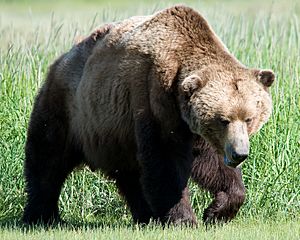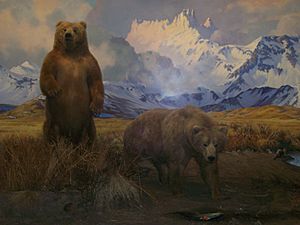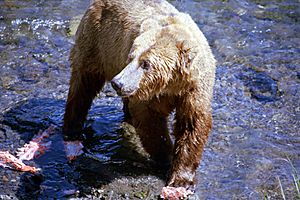Alaska Peninsula brown bear facts for kids
Quick facts for kids Alaska Peninsula brown bearTemporal range: Late Pleistocene – Recent
|
|
|---|---|
 |
|
| Brown bear in Hallo Bay, Katmai National Park, Alaska, the USA | |
| Conservation status | |
| Scientific classification |
|
| Kingdom: | Animalia |
| Phylum: | Chordata |
| Class: | Mammalia |
| Order: | Carnivora |
| Family: | Ursidae |
| Genus: | Ursus |
| Species: | |
| Subspecies: |
U. a. middendorffi / horribilis
|
| Trinomial name | |
| Ursus arctos middendorffi / horribilis Merriam, 1902
|
|
The Alaska Peninsula brown bear is a very large type of brown bear. It lives along the coast of southern Alaska. Some people call it a "peninsular grizzly." Scientists often consider it a population of the mainland grizzly bear (Ursus arctos horribilis). Others link it to the even bigger Kodiak bear (U. a. middendorffi).
These bears are among the largest in the world. They can weigh from 800 to 1,200 pounds (363 to 544 kg). They live in large numbers along the southern Alaskan coast. This is because they have lots of food. They eat clams, sedge grass, and especially salmon. The yearly salmon runs help them grow to huge sizes. Many bears gather at feeding spots like Brooks Falls in Katmai National Park.
Biologists agree that coastal bears are true brown bears. All North American brown bears, except the giant Kodiak bears, are usually called horribilis. To make it simple, many people just call all North American brown bears "brown bears." This includes the Kodiak bears.
Hunters value these bears for their size. About 500 of Alaska's 1,500 brown bears hunted each year come from the Alaska Peninsula. Hunters must follow strict rules. These include limits on how many bears they can hunt. They also need to pay fees and use proper rifles.
What's in a Name?

The name "Alaska Peninsula brown bear" came about for a reason. Before 1975, people thought it was a different species. It was seen as separate from the grizzly bear found inland. This was mainly because coastal bears are bigger. They also have different fur colors than inland grizzlies.
After 1975, scientists decided they were the same species. But the coastal bears kept the name "brown bear." So, "brown bear" and "grizzly bear" often mean the same animal. They just live in different areas. Brown bears live near the coast, and grizzlies live inland.
Coastal bears grow larger because their diet is rich in salmon. This food helps them gain a lot of weight. There are about 32,000 brown bears in the U.S. Most of them, about 30,400, live in Alaska. Around 4,000 of these are coastal bears. Alaska has very strict rules for managing its wildlife.
How Big Are These Bears?
Alaska Peninsula brown bears are some of the biggest brown bears. They can be about 8 feet (2.4 meters) long. Their shoulder height is usually around 4.4 feet (1.3 meters). Their hind feet can be 11 inches (28 cm) long.
One study found that male coastal bears weigh about 900 pounds (408 kg). Females are smaller, weighing around 500 pounds (227 kg). But some huge males have been recorded. They can weigh up to 1,500 pounds (680 kg). A very large male can stand 10 feet (3 meters) tall on its hind legs. It can be 5 feet (1.5 meters) tall at the shoulder.
The biggest bear ever recorded was shot in 1948. It was near Cold Bay, Alaska. Its weight was thought to be 1,600 to 1,700 pounds (725 to 771 kg). This bear had just woken up from hibernation. It had very little fat. So, it would have weighed about 1,850 pounds (839 kg) at the end of summer.
Their fur color can vary a lot. It ranges from blonde to almost black. But grizzly bear fur is usually brown with white tips. These bears have a clear hump on their shoulders. This hump helps tell them apart from black bears. Black bears do not have this hump.
What Do They Eat?

Brown bears on the Alaskan Peninsula mostly eat salmon. They have many clever ways to catch them. Some bears wait at the bottom of waterfalls. They catch fish as they jump up. Others stand at the top of the falls. They try to grab fish in mid-air, sometimes with their mouths! Bears are also good at chasing fish. They use their claws to pin the slippery fish.
After the salmon season, bears eat berries and grass. This helps them build up fat. They need this fat for hibernation. Hibernation is a long sleep during the winter.
See also
 In Spanish: Oso pardo de la península de Alaska para niños
In Spanish: Oso pardo de la península de Alaska para niños


